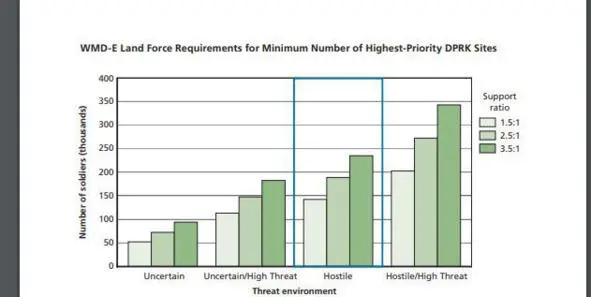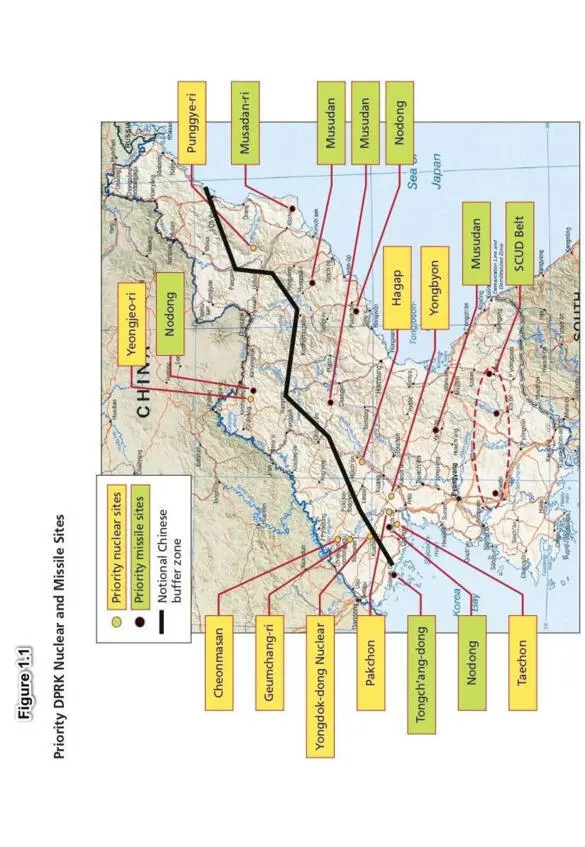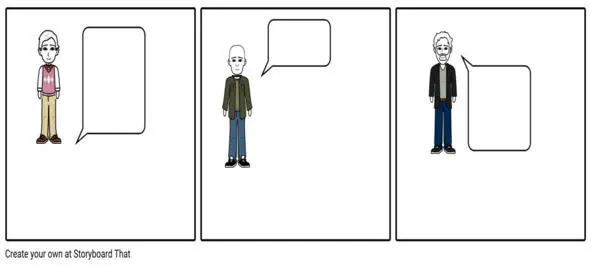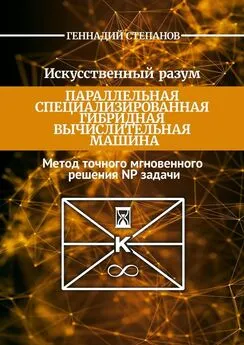Марина Грабарь - Английский для военных/Military English. Метод кейсов/Cases. Решения, ответы, словарь, глоссарий
- Название:Английский для военных/Military English. Метод кейсов/Cases. Решения, ответы, словарь, глоссарий
- Автор:
- Жанр:
- Издательство:неизвестно
- Год:неизвестен
- ISBN:9785449881755
- Рейтинг:
- Избранное:Добавить в избранное
-
Отзывы:
-
Ваша оценка:
Марина Грабарь - Английский для военных/Military English. Метод кейсов/Cases. Решения, ответы, словарь, глоссарий краткое содержание
Английский для военных/Military English. Метод кейсов/Cases. Решения, ответы, словарь, глоссарий - читать онлайн бесплатно ознакомительный отрывок
Интервал:
Закладка:
We chose the 2.5:1 support ratiofor our baseline estimate to support WMD-E operations in the DPRK, and show the parametric variants of ratios higher or lower than this number.
Question 4
– Sensitivity of Force Requirements to Operational Environments and Support Ratios
The ground forcerequirements are presented as a function of the operating environment (Uncertain or Hostile, and level of threat) and the assumed support ratio (low, midlevel, or high), broken out by the different elements of the WMD-E mission force.
Ground force requirements for WMD-E operations in our illustrative DPRK case are presented in Figure 1.2.
Estimated forcesneeded for WMD-E operations could be…
Answer
Figure 1.2

Example:• 73,000 troops for an Uncertain environment – with a lower bound of 52,000 if significant contractor logistics support can be employed and an upper bound of 94,000 if all support must be provided by the U.S. military • 148,000 for an Uncertain/High Threat environment – with a lower bound of 113,000 with more contractor logistics support and an upper bound of 182,000 with all U.S. military support.
Since we thinkthat the environment is likely to be Hostileand that the intermediate levelof support will be needed in the DPRK, our best estimate is a requirement for 188,000 U.S. ground troops.
That estimate could decrease to 148,000 if the risk of attack from DPRK militaryremnants decreases.
It could increase to 273,000 if the environment worsens to become High Threat. It is also useful to recall that these estimates are for the WMD-Emission only – they do not include force requirements for other missions, such as humanitarian assistance.
These different security levels pertain to the disposition of the DPRK security forces and any insurgent forces that might rise up.
Question 5
5. Observations on the DPRK Case Study
As described in this case study, WMD-E operationsin the wake of a collapse of the DPRK.
1.What are the assumptionsdriving results?
– What does Your results suggest?
Answer
The WMD-E requirementis a nontraditional missionthat creates a need for forces in addition to those required for joint operations, the force requirements of which might already be quite large.
The key assumptionsdriving results are the following:
– • the number and sizes of the WMD sitesthat are to be searched, the time needed to clear each site, and the priority and urgency of clearing them
– • the degreeto which non-U.S. forces could or would be relied upon to service nuclear and nonnuclear sites
– • the ratio of supportto mission troops
– • the degree of hostilityin the operational environment, as well as the military threats WMD-E forces may face.
Our results suggestthat even in cases where relatively favorable assumptionsare made, the estimated U.S. forces required can still be quite substantial:
For example, in our DPRK base case, our estimate for the Uncertain environment – a relatively favorable environment for conducting WMD-E operations — requiredan estimated 73,000 troops,
while a more hostile operating environmentor more expansive
missionsrequired significantly more troops.
ActualWMD-E operations are likely to be far more challenging.
You can read the full version


CASE 2
Practical Speaking Training. Сrush the fear of public speaking
1. DRAW A CARTOON (Naval Admiral William McRaven`s addresses.)

https://youtu.be/pxBQLFLei70
What 1 lesson from this speech can you apply to your own life?
Directions:
Use the narrator’s descriptions to help you draw three Scenes and the characters.
– After you draw each scene, write what the characters talked or thought about.
– If the characters talk to each other, write their conversation in a speech bubble.
– Write a character’s thoughts about anything in a thought bubble.
Example: « If you want to change the world get over being a sugar cookie and keep moving forward.»
«There were many a student who just couldn’t accept the fact that all their effort was in vain… Those students didn’ t under-stand the purpose of the drill. You were never going to suc-ceed. You were never going to have a perfect uniform.»


As you brainstorm the story`s characters, think about which are their main
motivations. Which are their secondary ones?

Create your Speech.
The goal of this presentation is to show you how a speech success isn’t the re-sult of good luck, ability.
The speech success is simply a case of taking the steps required to introduce changes and bring revolution in every field, inspiration from your speech. How big your heart is.
Do you agree?
What were some of the main messages of this particular speech?
List the main points and themes.
– Oratory – What words or phrases helped to support the speech’s main pur-poses? In particular, which words or phrases evoked emotion, painted a strong image or are very descriptive. How do the words and phrases you’ve pointed out lend to (or distract from) the points being made?
– Emotion – What emotions do you believe Naval Admiral William McRaven was trying to evoke? Do you believe this was achieved? If so, what words in particular helped to convey emotion?
– Audience – To whom is Naval Admiral William McRaven trying to appeal? What words help you come to this conclusion?
– Delivery – What do you notice about Naval Admiral William McRaven `s use of elements like tone of voice, inflection, pause, pacing, rising and falling volume and body language to emphasize specific points in the speech?
There are many issues you can talk about at your inauguration. How do you pick one? A good idea is to look inside yourself and find out what you feel very deeply about. Maybe it’s the environment. Or you feel that downloading music on the Internet should be free. Your issue should reflect who you are and what you care about.

DRAW A CARTOON
1. Establish your character by asking each other
«wh’ questions (who, what, when, where, why and how). You should then discuss any points that they think are im-portant to support your point of view.
2 Storyboard Creator makes amazing visuals and graphic
https://www.storyboardthat.com/
– Organizers for digital storytelling.
– The role play can begin.
You have a maximum of three minutes to present your story.
– After the role-play is finished, an issue.
– Making notes will help you to remember the important points.
Example:

Write your speech.
– Keeping it simple
1. Write Like You Talk
Remember that you’re writing a speech, not an essay.
People will hear the speech, not read it.
– Use short sentences. It’s better to write two simple sentences than one long, complicated sentence.
– Use contractions. Say «I’m» instead of «I am» «we’re» in-stead of «we are.»
– Don’t use big words that you wouldn’t use when talk-ing to someone.
– You don’t have to follow all the rules of written English grammar.
«Like this. See? Got it? Hope so.»
– Always read your speech aloud while you’re writing it.
You’ll hear right away if you sound like a book or a real person talking!
– Use Concrete Words and Examples
Concrete details keep people interested. For instance, which is more effective? A vague sentence like «Open play spaces for children’s sports are in short supply.» Or the more concrete «We need more baseball and soccer fields for our kids.»
– Get Your Facts Together
You want people to believe that you know what you’re talking about!
So you’ll need to do some research.
For instance, let’s say your big issue is the environment. You promise to pass a law that says all new cars must run on electricity, not gas. That will cut down on air pollution! But it would help if you had a few facts:
How much bad air does one car create each year? How many new cars are sold in the world every year? So how much will pollution be cut every year?
Use the library or the Internet to do research. Your new policy proposal will sound really strong if you have the facts to back it up.
5. Persuade With a Classic Structure
In a speech where you’re trying to persuade someone, the classic structure is called «Problem-Solution.» In the first part of your speech you say, «Here’s a problem, here’s why things are so terrible.» Then, in the second part of your speech you say, «Here’s what we can do to make things better.» Sometimes it helps to persuade people if you have statistics or other facts in your speech. And sometimes you can persuade people by quoting some-one else that the audience likes and respects.
Читать дальшеИнтервал:
Закладка:










